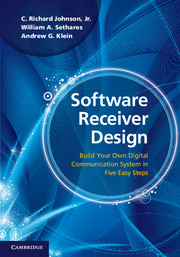16 - A Digital Quadrature Amplitude Modulation Radio
from Step 5 - Putting It All Together
Published online by Cambridge University Press: 05 June 2012
Summary
The preceding chapters of Software Receiver Design focus on a real-valued PAM transmission protocol. Though this is one of the simplest digital transmission systems, a working radio for PAM needs to include a variety of techniques that address the nonideal behaviors encountered in reality. Fixes such as the PLL, the Costas loop, timing recovery, and equalization are necessary parts of the system. This chapter describes a complex-valued generalization of PAM called quadrature amplitude modulation (QAM), which forms the basis of a “better radio.” While the change from real-valued PAM to complex-valued QAM signals is straightforward, the bulk of this chapter fleshes out the details of operation of the resulting system. The various parts of the digital radio need to be rethought (carrier recovery, timing recovery, and equalization). The theme of this chapter is that such rethinking can follow the same path as the original designs. The basic techniques for the PAM radio of earlier chapters generalize smoothly to more sophisticated designs.
This chapter begins with the observation (already noted in Section 5.3) that PAM modulations waste bandwidth. QAM, a more clever modulation strategy, is able to halve the bandwidth requirements, which represents a significant step towards practicality. This is accomplished by sending, and then unravelling, two real PAM signals simultaneously on orthogonal carriers (sine and cosine) that occupy the same frequency band.
Information
- Type
- Chapter
- Information
- Software Receiver DesignBuild your Own Digital Communication System in Five Easy Steps, pp. 357 - 403Publisher: Cambridge University PressPrint publication year: 2011
